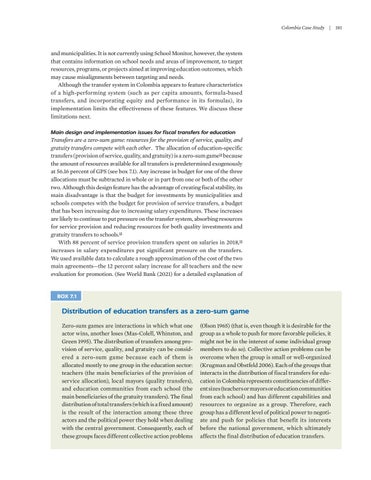Colombia Case Study | 181
and municipalities. It is not currently using School Monitor, however, the system that contains information on school needs and areas of improvement, to target resources, programs, or projects aimed at improving education outcomes, which may cause misalignments between targeting and needs. Although the transfer system in Colombia appears to feature characteristics of a high-performing system (such as per capita amounts, formula-based transfers, and incorporating equity and performance in its formulas), its implementation limits the effectiveness of these features. We discuss these limitations next. Main design and implementation issues for fiscal transfers for education
Transfers are a zero-sum game: resources for the provision of service, quality, and gratuity transfers compete with each other . The allocation of education-specific transfers (provision of service, quality, and gratuity) is a zero-sum game14 because the amount of resources available for all transfers is predetermined exogenously at 56.16 percent of GPS (see box 7.1). Any increase in budget for one of the three allocations must be subtracted in whole or in part from one or both of the other two. Although this design feature has the advantage of creating fiscal stability, its main disadvantage is that the budget for investments by municipalities and schools competes with the budget for provision of service transfers, a budget that has been increasing due to increasing salary expenditures. These increases are likely to continue to put pressure on the transfer system, absorbing resources for service provision and reducing resources for both quality investments and gratuity transfers to schools.15 With 88 percent of service provision transfers spent on salaries in 2018,16 increases in salary expenditures put significant pressure on the transfers. We used available data to calculate a rough approximation of the cost of the two main agreements—the 12 percent salary increase for all teachers and the new evaluation for promotion. (See World Bank (2021) for a detailed explanation of
BOX 7.1
Distribution of education transfers as a zero-sum game Zero-sum games are interactions in which what one actor wins, another loses (Mas-Colell, Whinston, and Green 1995). The distribution of transfers among provision of service, quality, and gratuity can be considered a zero-sum game because each of them is allocated mostly to one group in the education sector: teachers (the main beneficiaries of the provision of service allocation), local mayors (quality transfers), and education communities from each school (the main beneficiaries of the gratuity transfers). The final distribution of total transfers (which is a fixed amount) is the result of the interaction among these three actors and the political power they hold when dealing with the central government. Consequently, each of these groups faces different collective action problems
(Olson 1965) (that is, even though it is desirable for the group as a whole to push for more favorable policies, it might not be in the interest of some individual group members to do so). Collective action problems can be overcome when the group is small or well-organized (Krugman and Obstfeld 2006). Each of the groups that interacts in the distribution of fiscal transfers for education in Colombia represents constituencies of different sizes (teachers or mayors or education communities from each school) and has different capabilities and resources to organize as a group. Therefore, each group has a different level of political power to negotiate and push for policies that benefit its interests before the national government, which ultimately affects the final distribution of education transfers.






